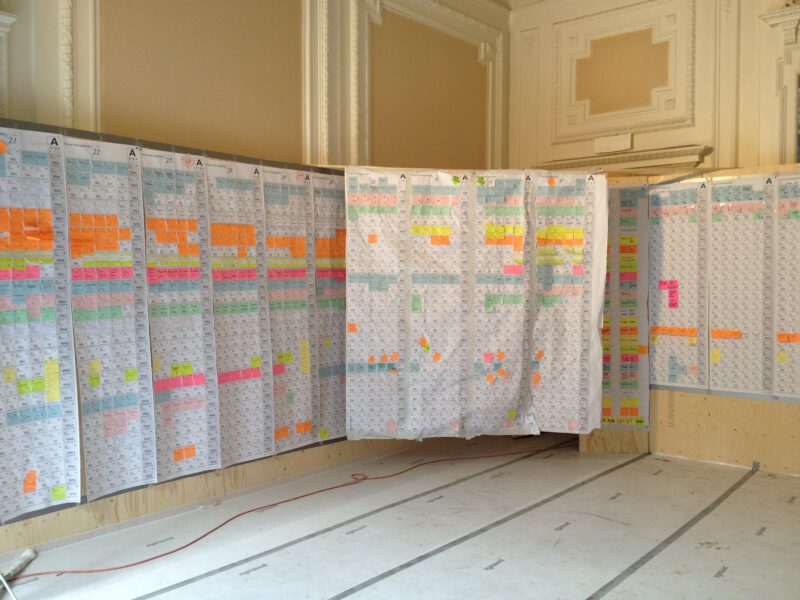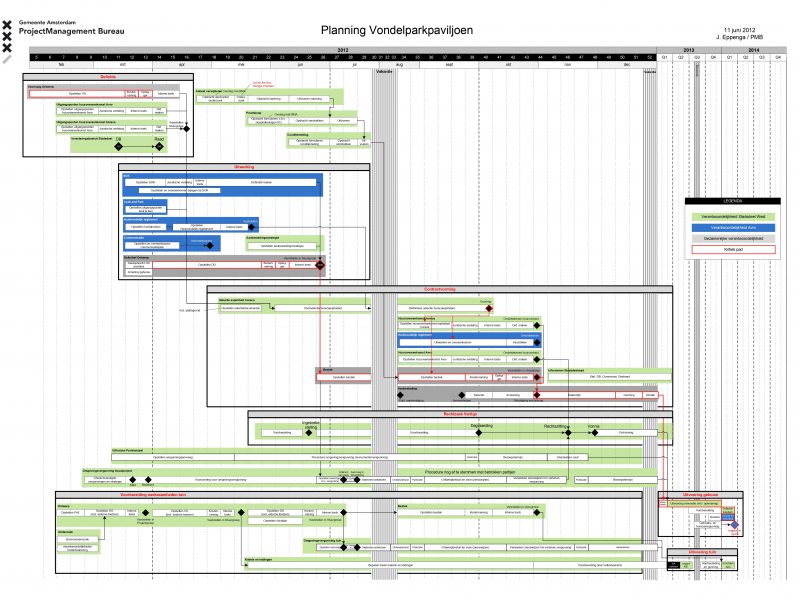 The topics during the second week the Design and Construction Management-course were the Brief and managing, being the next step after the scope and leadership of the first week.
The topics during the second week the Design and Construction Management-course were the Brief and managing, being the next step after the scope and leadership of the first week.
The brief is all about the information needed to start a project and managing is related to ?being in control? of that information. The assignment dealt with the interaction of these two topics.
To deal with complex projects (where large investments, time constraints and quality control are at stake) tools and methods are developed. But, as we have seen, also personal and social skills are needed to bring complex projects to a satisfying conclusion.
This post is about process phasing.
One important way to get a hold on complexity is to work with a step by step approach. To be able to manage a project, phasing is needed to steer from idea to reality and manage the information flow from paper to stone (in a building project). The end of every step gives you, the manager, the opportunity to reflect, to check and to see if you are on track or not (Winch calls this the general information loop, p 180). It also gives you the opportunity to discuss deviations with your client and the agents. It gives you the opportunity and the moment to (formally) adapt plans or designs if needed. In the building industry this phasing is more or less standardized and everyone in the field is acquainted with it. (Winch part IV, Wamelink et. all)
Architects and advisers have aligned their contracts (and payments) with the standardized steps of the project life cycle. You can read it in the DNR (De Nieuwe Regeling), being the Dutch juridical framework of contracts between clients and agents. Most of the steps align with life cycle of a project. The architects work however will be different than the work of the manager. For instance, during feasibility phase more work is done by the manager and in most projects the architect is not, or only for a small part involved.
But watch out with standardized stuff!
Standardized procedures could distract you from the things your project (and your client) really needs. All projects need procedures based on experience and tradition, but mayor projects are unique and have their own features that deviate from standards. Trust your intuition and your attentiveness!
Phasing is not a law and you can adjust it to the project at hand. Based on experience and intuition you design your project to the special needs of it. One of the groups proposed to insert the BID to the owner (Rijksvastgoedbedrijf) as a separate phase. I think that is smart, if you recognize the impact the bid can have. It is maybe the most important step in your project. If your bid is resigned by the owner, the project is over!
The goal and advantages of phasing are mentioned in Winch in part IV. The end of every phase gives you the opportunity to (1) measure performance, to (2) compare it with the brief and to (3) take action. At the end of every phase you can (a) change the plan, (b) adapt the budget or (c) change other objectives. You can also, with the set of phase documents, ask (formal) approval by your client. In this way you have a sound base to move on to the next step of the project; with or without instructions or improvement tasks.
The difference between stages
Looking at the stages of a project you recognize huge differences. If you look to the chart of your assignment you see, per stage, differences in goals, in stakeholders, in products, in outcomes, and also in the risks or uncertainties and the solutions at hand. For example, during the definition phase you do not have to worry about the contract with the builder or the specific details of the building permit. When time comes you can work on that and solve its? specific problems.
There is also a great difference in the organization during the projects? life cycle. The organization of the design phase is different because (in traditional projects) the contractor is not involved. And the essence of the work is different as well: solving the design problem in the design phase and during construction solving the problems of execution.
The relation between the different stages
For me the relation between the stages is twofold.
The first relation between all phases deals about the content. The project is ?build? from rough ideas to detailed plans and eventually to the real building. All the next steps are based on the assumptions of the previous ones. The next phase is, if it comes to information, more detailed than the previous.
The next relation between phases is the approval by the client. Normally not all of the output at the end of a phase is perfect. Therefore the approval comes along with new instructions or with the assignment to adjust plans to the clients? brief or budget. It could also be that a project scope is introduced, together with maybe extra budget or a new time frame.
Conclusion
Bottom line, phasing a project gives the manager the opportunity to steer, to manage, to lead, to govern. By phasing the life cycle the manager is able to work from rough to detailed and adjust plans, the brief and design in a structured and understandable way if needed.
DNR: DNR English version
STB: Dutch version with process steps







1 comments
You asked us, the students, to reply and start a discussion if you want. But if you write such a clear and eleborate blog, how can we?! 🙂